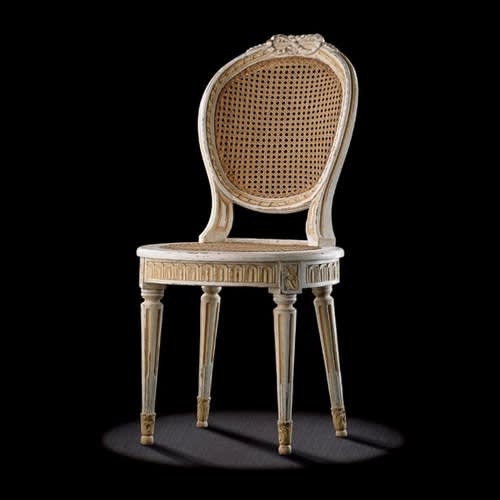
Christian Dior
Lady Dior Handbag with Cannage Motif
What visuals transpire when thinking about the house of Christian Dior? Is it the soft shoulders, nipped waist and full skirts of the 1947 ‘New Look’? The outlandish excess and embellishment of Galliano-era Dior couture? The iconic dove grey interior of the brand’s Peter Marino-designed boutiques? Or, is it the cannage pattern that has become a symbolic motif for the house of Dior since its inception in the late 1940s?
Caning, an old fashion technique of weaving on a frame using rattan cane, first appeared on the seats and backs of chairs in the mid 18th century. The decorative motif soon became synonymous with furniture design throughout Western Europe during the reign of Louis XV, having appeared on sofas, armchairs and headboards.

18th Century Cannage Chair
From Christian Dior's First Défilé, 1947
Nearly two centuries later, Christian Dior debuted his first collection for his namesake French couture house amongst a sea of eighteenth century cannage chairs. Monsieur Dior, seemingly enchanted by the furniture’s design, began experimenting with the chair’s old fashion canning technique, eventually employing the pattern as a decorative motif for the brand’s “Eau Fraîche” perfume in 1953. In the years that followed, Dior’s predecessors returned to this theme often, incorporating the pattern within the designs of clothing, accessories and fine jewelry.
Christian Dior
Eau Fraiche, 1953
Christian Dior
Miss Dior, Diorama, 1953
Christian Dior
Miss Dior, Diorissimo, Diorama, 1962
Christian Dior
Diorama, 1966
Throughout the 1960s, creative director Marc Bohan developed a number of tweed and Op Art fabrics that took inspiration from canning, while in the 1980s, Gianfranco Ferrè produced dresses and coats in a fabric that mirrored canning in a more literally vein. In 1994, the French house introduced their first Lady Dior handbag, initially made of soft lambskin leather topstitched with the brand’s iconic Cannage motif.
Christian Dior by Marc Bohan, Op-Art Shifting Squares
Image by Richard Avedon for Harper's Bazaar, September 1965
Christian Dior by Marc Bohan
Cannage Pattern, 1960s
Christian Dior by Gianfranco Ferrè
Cannage Pattern, 1980s
Christian Dior
Lady Dior Handbag, 1990s
Canning quickly became a prominent architectural feature within Dior’s international flagship boutiques, while in the early 2000s, creative director John Galliano reinterpreted this classical motif through a post-modern lens with the introduction of the brand’s initial pattern, designed to resemble classic Dior canning through letters in place of lines.
Dior by John Galliano
Rasta Collection, Fall/Winter 2004
Dior by John Galliano
Rasta Collection, Fall/Winter 2004
Dior by John Galliano
Rasta Collection, Fall/Winter 2004
Dior By John Galliano
Rasta Collection, Fall/Winter 2004
In 2012 master jeweler Victoire de Castellane employed the pattern as primary inspiration behind a collection of fine jewelry named ‘My Dior’.
Christian Dior - My Dior
Jewelry Collection, 2012
Christian Dior - My Dior
Cannage Pattern Cuff Bracelet
Meanwhile, just days ago, Dior Homme’s newest creative director Kim Jones, presented his first menswear collection for the French house, throughout which countless models carried down the catwalk translucent, cannage print tote bags and duffels; some of which housed colorful, Dior-suited stuffed animals produced in collaboration with iconic American street artist, KAWS.
Dior Homme by Kim Jones
Spring/Summer 2019
Dior Homme by Kim Jones
Spring/Summer 2019
Dior Homme by Kim Jones
Spring/Summer 2019
While monsieur Dior’s favorite pattern has been featured less prominently throughout the womenswear collections of designer Maria Grazia Chiuri, if Kim Jones’ initial show is any indication, Dior’s iconic motif will be alive and thriving for many seasons to come.


